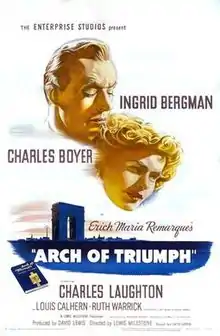Arch of Triumph (1948 film)
Arch of Triumph is a 1948 American romantic war drama film directed by Lewis Milestone and starring Ingrid Bergman, Charles Boyer and Charles Laughton. It is based on the 1945 novel Arch of Triumph by Erich Maria Remarque, which he wrote during his nine-year exile in the United States.
| Arch of Triumph | |
|---|---|
 Film poster | |
| Directed by | Lewis Milestone |
| Produced by | David Lewis |
| Written by | Lewis Milestone Harry Brown |
| Screenplay by | Lewis Milestone Harry Brown Irwin Shaw (uncredited) |
| Based on | Arch of Triumph by Erich Maria Remarque |
| Starring | Ingrid Bergman Charles Boyer Charles Laughton |
| Music by | Louis Gruenberg |
| Cinematography | Russell Metty |
| Edited by | Duncan Mansfield |
Production company | Enterprise Productions |
| Distributed by | United Artists |
Release date |
|
Running time | 120 minutes 133 minutes (restored version) |
| Country | United States |
| Language | English German |
| Budget | USD 5,000,000[1][2] |
| Box office | $4,250,000[3] $1.7 million (US rentals)[4] $4,100,000 (total)[3] |
Synopsis
Pre-World War II Paris is crowded with illegal refugees, trying to evade deportation. One of them is Dr. Ravic (Charles Boyer), who under a false name practices medicine illegally, helping other refugees. He saves Joan Madou (Ingrid Bergman) from committing suicide after the sudden death of her lover. They become involved, but he is deported and she becomes the mistress of a wealthy man, Alex (Stephen Bekassy). All this time Ravic seeks revenge against the Nazi officer Haake (Charles Laughton), with war eventually declared between France and Germany.
Cast
- Ingrid Bergman — Joan Madou
- Charles Boyer — Dr. Ravic
- Charles Laughton — von Haake
- Louis Calhern — Boris Morosov
- Ruth Warrick - Kate Bergstroem
- Roman Bohnen — Dr. Veber
- J. Edward Bromberg — Hotel manager at the Verdun
- Ruth Nelson — Madame Fessier
- Stephen Bekassy — Alex
- Curt Bois — Tattooed waiter
- Art Smith — Inspector
- Michael Romanoff — Capt. Alidze
Background and production
The film's name is a reference to the Arc de Triomphe in Paris, where the film is set. The rough cut of the film was four hours long, and in reducing it to two hours several actors were cut. Irwin Shaw spent five months writing the screenplay, but quit when Lewis Milestone wanted him to add a love story. Milestone then rewrote the script himself together with Harry Brown. Ingrid Bergman's salary for the part was $175,000 + 25% of net profits.
William Conrad, in just his fourth film, has a small important (uncredited) role, as a policeman.
The MPAA's head of the Production Code Administration at the time, Joseph Breen, made the film's studio tone down the violence in the script. The scene where Ravic kills Haake also included him stuffing Haake in the car's trunk, stripping him naked, burying him and burning his clothes — this was cut from the film. Breen also objected to the murder going unpunished, but relented. Breen's initial objection contradicted the novel which made clear that Haake was a torturer whose many victims included Ravic and a girl he loved.
1984 remake
The film was remade in Britain in 1984 under the same title as a made-for-television movie with Anthony Hopkins as Dr. Ravic, Donald Pleasence as von Haake, Lesley-Anne Down as Joan Madou and Frank Finlay as Boris Morosov. The director was Waris Hussein.[5] It was released in America in 1985.[6]
See also
- Production Code
References
- Brady, Thomas F. (1 February 1948). "Hollywood Deals - Prospects Brighten for United Artists - Budget Runs Wild and Other Matters". The New York Times. p. X5. Retrieved 29 March 2016.
- Balio, Tino (2009). United Artists: The Company Built by the Stars. University of Wisconsin Press. p. 217. ISBN 978-0-299-23004-3.
- "Ent's Loan". Variety. 14 July 1948. p. 12. Retrieved 29 March 2016.
- "Top Grossers of 1948". Variety. 5 January 1949. p. 46. Retrieved 29 March 2016.
- BFI Screenonline: Hussein, Waris (1938- ), screenonline.org.uk. Retrieved 18 January 2021.
- John J. O'Connor, "'Arch of Triump,' Paris on the Eve of World War II", The New York Times]], 29 May 1985. Retrieved 18 January 2021.